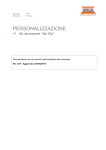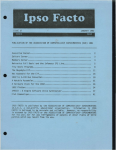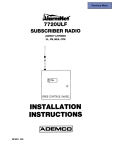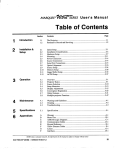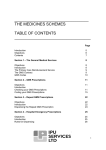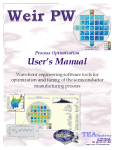Download Automatic intertext column spacing
Transcript
United States Patent [191 [11] Patent Number: Horn et al. [45] [54] 4,223,393 AUTOMATIC INTERTEXT COLUMN Date of Patent: Nov. 27, 1984 9/1980 Abe et al. .......................... .. 364/900 SPACING OTHER PUBLICATIONS [75} Inventors: gag ?lial-t1}; xéinneth 0' shmp’ Jr" ° [73] Assignee: 4,484,826 ° "8"" IBM Technical Disclosure Bulletin, “Column Equaliza 6" tion,” Howell et al., vol. 25, No. 1, Jun. 1982, pp. International Business Machines Corporation, Armonk, NY. 388—390. IBM Program Product “Documentation Composition . Facility/User’s Guide”, Second ed., Apr. 1980, No. [2]] App!‘ No" 305’255 SH20-9l61-1, Ch. 5, pp. 67-69. [22] Filed: Sep. 24, 1981 , [51] [52] Int. Cl.3 ............................... .. B41J 25/18 US. Cl. ...................................... .. 400/279; 400/3; [58} Field of Search ................... .. 400/2, 3, 63, 64, 67, , . Primary Examiner-Ernest T. Wright, Jr. Attorney, Agent, or Fz'rm—-R. Bruce Brodie 400/76; 400/83; 364/900; 340/720 [57] ABSTRACT In a column layout operation in an interactive word 400/68, 76, 83, 279, 705.4, 705.5; 364/200, 900; processing system, the unoccupied character escape 340/720, 721, 723, 724 References Cited ment along a column example line is automatically evenly distributed by the insertion of an appropriate number of space characters responsive to the stroking of a predetermined function key. [56] U.S. PATENT DOCUMENTS 3,952,852 4/1976 Greek et al. 4,207,0ll 6/ 1980 400/279 3 Claims, 6 Drawing Figures Pascoe ............................... .. 400/279 (.2...-:....3....:-.,.b....:....5.... :....6..,.:....7....:....B....:.t.-> :Hlllllllallli ‘Ill-8B!!! llIBiBB-I _ (luutuulthznnlan.,:....S.-‘. :H..15....:..,.7....:....8....:.-..>> yuan-anal“ laaanaa- ea lllllllI l 4 graphics : total col widths lm ft margin ml 1 right margin rte eel = right tai?e edge = coi example line r = reminder no. :tra Spaces of " uuttev'sv # uranium 7 ' graphics \ NO _ .‘Qmw YES Uutterw'dtn'ilrte-lwn: gram,“ ~ gTtTers * r I (Jitters r_‘“‘::':; * ~ *— -‘ —A~~___ 5 distribute stun gutter delete spams lnsszc‘ol D l U l “"7 / / <\ l insert A q suaces l l HHS?! i utl spaces. l US. Patent Nov. 27, 1984 Sheet 5 0f6 4,484,826 <.2. . . . : . . . .3. . . . : . . . .4. . . . :. . . .5. . . . : . . . .6 . . . . : . . . .7. . . . : . . . .8. . . . : . . . .>> gaaaaaaaaaaaaa aaaaaaanaa aaaaaaaoa <2. . . . : . . . .3. . . . : . . . .4. . . . : . . . .5. . . . : . . . .6. . . . : . . . .7. . . . : . . . .8. . . . : . . . .» gaaaaaaaaaaaaa aaaaaamaa aaaaaaa-a # graphics = totaI coI widths Im = left margin rm = right margin rte right tabie edge C61 r (:01 exampIe I ine remainder no. of xtra spaces 5C6" C81} # C015. _ # gutters. # QY?PhICS _ _ _ _ _ _ _ _ _ g _ _ a _ _ I find - I I I I rte # graphics > (rm-1m) I rtez=rm I I I I gutterwidth: =(rte-Irn)-# graphics # gutters : q + r # gutters I'- _ _ — _ — ______ " —‘__ _—_'— __| I ciistribute I I scan gutter I $222201 deIete spaces I I I - gutters > 0 I I I I I # gutters-1 ' p N0 q insert spaces 9 I I I I YES insert q+I spaces; r:=r-I I l I I I I L_ _________ __ ______ ____I J 4,484,826 1 2 display screen, a keyboard, a memory for storing for matted information, and an intercoupling microproces AUTOMATIC INTERTEXT COLUMN SPACING sor. In the Horn, et al., type of prompting interactive FIELD OF THE INVENTION word processor, multiple text column tables are format This invention relates to word processing, and more particularly, to a machine assisted interactive method ted prior to text entry by invoking a column layout and means for evenly adjusting the gutters between columns during formatting of multiple text columns on a page in a word processing system. 10 BACKGROUND ART Pascoe, U.S. Pat. No. 4,207,011, issued June 10, i980, describes the formatting of sequentially stored text col function mode. Consonantly, menued prompts promi nently displayed guide the operator in order to struc ture the column widths and gutters (intercolumn spac— ing) by repeated keying of text characters or widths and then inserting space characters over to the next column position and repeatedly keying in text characters to de?ne the widths of yet another column. This single entry line permits the column and gutter widths to be automatically aligned with tab stops. The formatted column example line is then vector encoded and saved. umns by embedding semaphore codes. Upon the side by»side printout of the stored text columns, the embed ded codes preserve a synchronous relationship between their varying line spacings. That is, a code character in If it is subsequently desired to revise a saved table, its encoded format line is recalled, rebuilt, and then revised by entering repeated text and control characters to line i initiates a memory scan to ascertain the existence of any counterpart line i to be printed from column 2. Greek, et al., US. Pat. No. 3,952,852, issued Apr. 27, 20 de?ne an altered width of an existing column or a new column. In turn, the revised column example line may 1976, discloses a system having a keyboard and printer, be encoded and saved. There is also provided an auto a buffer and control, and a multicolumn playout control matic one character wide gutter insertion when creating unit. During set-up, a tab ?eld for de?ning the printing a new column to prevent the operator from failing to locations of the column, can be set up by operator key. The columns, which are stored sequentially, are printed 25 include a gutter after formatting his adjacent column. out in a side-by-side manner, the beginning of each The Invention column being de?ned by the keying of a column begin code. In contrast, word processing systems where text stream input is stored and displayed, tables of multiple It is an object of the inventive method for evenly adjusting the gutters between columns during the for columns of text or data are formatted by an operator 30 matting of multiple text columns on a page in an interac involving a displayable scale line on the system. The tive word processing system formed from a keyboard, display, memory for storing formatted information, and an intercoupling microprocessor. The method steps operator independently ascertains column widths and gutters, and then must count and enter the tab stops along the scale line. Word processing is to be distinguished from text processing in both the kind and degree of facilities avail include operator keyboard entry of a line of at least two able to the operator. Text processing involves the use of a large capacity CPU shared among multiple terminals empowered with a text processor such as SCRIPTS/V S having rapid access to megabytes of fast 40 DASD storage. In text systems, threaded data lists exe column width examples formed from repeated text and control characters; and responsive to function key actu ation, the machine step of modifying the example line by the automatic insertion of spaced characters in the gutters between the column examples proportional to the unoccupied escapement between the page margins cuted in SCRIPTS permits ?exible operator formatting divided by the number of gutters. In addition to auto taking advantage of the sophisticated processing opera matically producing even spacing between each column within the vertical page margins, there is also executed the additional step of adjusting the tab stops within each column accordingly. Advantageously, this method is in harmony with other column layout functions-by-example. Generi tions on list pointers and indices. To the contrary, word processing is focused on stand-alone terminals in which 45 letters, small documents, and memos are processed by microcomputers interacting with limited diskette stor age of 200 or 300 kilobyte capacity. The documents and pages are processed as end marked, semi-in?nite, simply cally, an operator “teaches" the word processor to structured character strings with few embedded con format text data for use in a multiple text column table trols. The comparative absence of highly elaborated by way of dummy illustration supplemented by auto data structures saves memory but requires special for matic assistance. matting considerations, such as documents composing BRIEF DESCRIPTION OF THE DRAWING for tables and the like. In the IBM Program Product “Document Composi 55 tion Facility/User's Guide", Second Edition, April 1980, IBM publication No. SH20-9l6l-l, at Chapter 5, nal and external memory, a keyboard, a microprocessor, pp. 67-69, there is described multicolumn page layout for the SCRIPT/V S text processing system. SCRIPT de?nes a multiple column layout requiring operator speci?cation of column number, width, and left margin 60 position for each column. Thus, the prior art of inter column spacing is completely operator de?ned with Ser. No. 305,260, ?led on Sept. 24, 1981 there is de picted a multiple text column formatting method exe cuted in an interactive word processing system having a and intercoupling bus. FIG. 2 delineates a partial register organization of the microprocessor shown in FIG. 1. FIG. 3 is a display screen (soft copy) layout organiza tion of information as viewed by a word processor operator. limited, if any, automatic assistance. In the co-pending Horn and Shipp application, U.S. FIG. 1 depicts a word processor system con?gura tion including soft and hard copy output facilities, inter 65 FIG. 4 shows table and column layout spatial de?ni tions. FIG. 5 depicts the method flow diagram of the inven tion. 3 4,484, 826 FIG. 6 is a PASCAL source code implementation of the machine response to the operative function key stroke of the method. DESCRIPTION OF THE PREFERRED EMBODIMENT AND INDUSTRIAL APPLICABILITY Brief System Machine Description Referring now to FIG. 1, there is shown a word processing system 10 which includes a keyboard 12 for receiving text character entries and transmitting the text through a path 14 to a microprocessor 16. A memory bus 18 couples processor 16 to a CRT display 20, dis 4 control section 36 is connected through a channel 42 to text storage buffer 28. A text storage buffer manager block 44 is coupled through a channel 46 to the text storage buffer 28. Block 44 is further coupled through a channel 48 to the T58 control block 34. As each character is entered through keyboard 12, it is received at the memory 26 by the actions of one or more keystroke service routines in memory location or block 50. A keystroke control unit block 52 is a data area which determines the selected keystroke routine for processing the received character. Block 52 is linked to the keystroke service routine in memory location or kette drive 22, a printer 24. and a random access mem‘ block 50 through channel 54. The keystroke service ory 26. Keyboard 12 preferably should exhibit a set of routine block 50 is further linked through a channel 56 to the text storage buffer control block 34 and through channels 58 and 60 to TSB manager block 44. The active format storage section 30 is connected through channel 62 to the keystroke service routine block 50. The diskette buffer 32 is connected through channel 64 to the keystroke service routine block 50. The text characters and control information in TSB 28 are communicated through channel 66 to a display actuable key faces of any standard alphanumeric char acter set together with function keys. The function keys are in effect mode switches. That is. a function key upon operator actuation operates as an event driver. It inter rupts microprocessor 16 which then task switches the processor 16. This suspends execution of the current task and transfers control to the starting address of the instruction string resident in memory 26 of the program bound or associated with the function key. Such task switching involves saving the contents of principal registers and transferring to a program counter the starting address of the first location in memory 26 of the program. The program counter causes the contents to be read out from RAM 26 and transferred to a program decoder or functional equivalent thereof for execution. Since the binding of speci?c programs to function keys and task switching upon function key actuation is well access method block 68. This serves as an interface for the display 20. Corresponding access method blocks for the keyboard 12, diskette drive 22, and printer 24 are substituted when communications with these units is required. Display control block 70 is connected through path 72 to the access method block 68. Partial Machine Register Organization, Data, and Control Flow known to the art further description thereof shall not be Referring now to FIG. 2, there is illustrated the con made. temporary machine register organization of processor An operator enters a text stream through the key 35 16. Such a processor 16 may be commercially imple board 12. Each page of text is stored and processed in memory 26. As the text stream is received in the mem ory 26, it is simultaneously presented to display 20. After the buffering of the text in text storage buffer 28 mented as, for example, by an Intel Corporation micro processor model 8086. According to FIG. 2, the proces sor 16 includes a control logic unit 80, which responds of memory 26. the stream can be saved on diskette drive 40 to an interrupt on device bus 82 from keyboard 12. Logic unit 80 is also connected to a data and address bus 22 or hard copy printed out on printer 24. 84 intercoupling other logic elements. Memory 26 includes a number ofdata areas and func In response to a fetch instruction from random access tional programs for operating with the text stored in memory 26, logic unit 80 generates control signals to system 10. The text and related control function are saved in a text storage buffer 28 which includes an 45 other elements. ‘The signals are coupled by way of path 86, illustratively connecting ALU 88. Synchronous active format storage section 30 and a diskette buffer 32. operation of unit 80 and other logic elements is ensured The keyboard character set (KB/CS) for the document» by way of clock pulses from an external clock source ing process is available in the active format storage transmitted over path 90. Data and instructions to be section 30. executed by processor 16 are entered over logic unit 92. As each character is entered through the keyboard Data also may be entered by way of a programmed 12. it is processed by one or more of the keystroke service routines stored in memory location or block 50 input/output logic 94. Logic unit 92 couples storage elements of RAM 26 and receives instructions by pro cessing data from the [/0 control 94 or from RAM 26. stored in text storage buffer 28 is simultaneously entered Device controlled information from processor 16 is into display refresh buffer 76. This buffer 76 drives 55 as executed by processor 16. Also, the text stream display 20. The diplay control block 70 and display access method block 68 provide a window which may be scrolled relative to the contents of the TSB 28. It should be noted that both the diskette drive 22 and printer 24 have dedicated buffer block areas assigned thereto. Lastly, block 70 serves to store ?ags and status passed by I/O control unit 94 and data bus 98. Input on data bus 98 from keyboard 12 is processed internally through processor 16 by instructions over bus 84 to logic unit 80 by ALU 88. ALU 88 in response to a signal on path 86 and in accordance with instructions received on bus 18 executes arithmetic operations stored in tem porary register 102. An external clock signal source simultaneously supplies clocking or strobe signals for synchronizing the buffer section 36. is included within the text storage 65 diverse transmission and memory accessing elements of the machine. Indeed. clock signals on path 90 are pro control block 34. Block 34 is linked through a channel information as required by the operation of block 68. l‘ext storage buffer control block 34 serves as the data area for the text storage buffer 28. A cursor control 38 to the active format storage section 30 and through a channel 40 to the text storage buffer 28. The cursor vided to each of the major elements. As can be seen in FIG. 2. a conventional microprocessor architecture is 5 4,484,826 set out, for example, a program counter 104 when incre 6 selectively suppressing text edit controls and reserving mented by the clock signals on path 90 speci?es location resources such as an allocation of memory. The table either in a register or in a memory for the next instruc formatting is executed by way of operator keying of tion to be executed. Data pointer register 106 and stack repeated text characters and controls as an example. pointer register 108 respectively contain pointers to the address location for recently entered characters, and, The “example line" is then encoded and saved. If the table is to be newly created, then the operator keys in a new format under a displayed scale line designated the the location in the memory of the instruction stack (i.e, to a last in, ?rst out, stack used for procedure and func tion calls, the storage of static variables, and temporary values during expression evaluation). Element 110 is a status register with reference either to availability or “column example line” by the repetitive keying of text and control characters. The tab rack constitutes column and gutter width information. Said tab rack is encoded as control bytes associated with the BEGIN TABLE (BT) control character. This information is saved. Thus, if the table is to be revised, then the “column example Prompting Word Processor Display line” is displayed and reconstituted according to the In a prompting word processor, display device 20 is 5 previously saved encoded information. At that time, the of the CRT type and is capable of setting out monos operator can key in revisions by way of example. Again, paced characters. In this regard, reference should be the revised layout is saved. made to FIG. 3. A typical display is partitioned such Automatic Intercolumn Spacing that lines 1 or 2 are status lines reflecting the informa tion state of the display. Next, lines 3 through 23 de?ne The method of the invention is invoked during a a viewpoint in which are set out menus, text, and infor column layout mode when an operator requests the mation necessary for interactive processing. Line 24 is a word processing system to “justify” the speci?ed col prompt line which provides information stepping the umns proportionally from each other and the speci?ed operator to the next menu function or activity. Lastly, margins. According to the method, the operator keys in line 25 is a message line which indicates whether mes 25 an example for each column specifying the width and sages are ?ashing or queued. the tab stops for each column. Each example must be A typical screen layout of the information state or separated by at least one space. This may be clearly seen display lines 1 and 2 is shown just above the portion of in the illustration shown at the top of FIG. 5. Each of FIG. 3 denominated “function”. Such a screen layout the column examples is under a scale line which regis could contain the volume number or identity of the 30 ters the tab stops. If the operator has keyed in the three content error. diskettes, task description, document name, the keying columns with varied spacing therebetween as repre mode such as insert or replace, and other specialized or reserved functions. sented by repeated text character “a"s, the intercolumn spacing function is invoked by stroking a dedicated (COLUMN LAYOUT) function key. The machine Column and Gutter De?nitions 35 responds by determining the amount of unoccupied line Referring now to FIG. 4, there is shown the gutter widths, dividing it by the number of gutters, and then and column width parameters specifying a set of adja inserting space characters so that the gutters between cent vertical columns starting at the table left margin adjacent columns are even. and extending to the right margin. Column and gutter Reference should be made to the method flow dia widths are de?ned in terms of the width of a character 40 gram also depicted in FIG. 5. Starting at the top, the included within a predetennined font or in absolute following method steps are responsive to the function escapement units such as V1440 inches per unit. In this key actuation after the operator has entered a column regard, a column width is preferably a multiple byte example line. First, the microprocessor 16 scans the number designating the width of a column text as the column example line to determine the number of col number of character units counted relative to the pre 45 umns, the number of gutters, and the number of graphic ceding gutter. Likewise, a gutter width is a multiple byte number designating the amount of white space in gins are known. After the scan, the next step is to ?nd character widths associated with a vertical column. The ?rst gutter width is speci?ed as a unit count relative to Thus, if the total column widths are greater than the the left margin. Other gutter widths specify unit counts relative to the right edge of the previous column widths. Multitext Column Layout Formatting By Example characters. In this regard, the left and right table mar the right table edge and assign it to the right margin. space between the right margin and left margin, then the right table edge is placed upon the end of the col umn example line escapement. If the total column widths fit within the right- and left-hand margins, then the right table edge is assigned to the right margin. The purpose of column layout functions in an interac~ Next, the even gutter width is determined as a function tive prompting word processing system 10 is to provide of the unoccupied space between the margins and the an opportunity for an operator to specify all of the number of gutters. This means that the distance be attributes of a column table format so as to permit im tween the right table edge and the left margin from which is subtracted the total column widths de?nes the plementing column functions such as delete, move, copy, and revise. These attributes include the widths of 60 total available unoccupied character escapement. If this each column, the tab stop within each column, and the quantity is divided by the number of gutters, then the spacing (gutters) between columns. In the copending Horn and Shipp patent application Ser. No. 305,260, quotient and remainder can be used to govern the actual insertion of space characters during the next step of ?led Sept. 24, 1981, there is described a method for distributing the available white space evenly. Starting at the beginning of the column example line, the inner column spacing is distributed to each gutter by formatting multiple columns either when creating a 65 new table or for revising existing tables by way of modi fying selected column widths or inserting a new column therein. The method involves initializing the system by the repetitive application of the steps of scanning the next gutter, deleting all the spaces in said gutter, and if 7 4,484,826 8 the remainder r is greater than ¢, then insert the integer quotient + 1 spaces and decrement the remainder r by 1. parallel to the method is set out between lines 8 and 47. Otherwise, insert the integer quotient of spaces. After space insertion, the number of gutters is diminished by l and, if greater than 0, the cycle is repeated until the number of gutters is equal to 0. counter registers, while a line 10 moves the cursor to In this regard, line 9 deals with initialization of all of the the start of the column example line. schematically, the program consists of a ?rst ‘while do’ loop between lines 11 and 24 which scans the en tered character example line to determine the line width, the total column width, and the number of gut ters. Lines 25 through 47 include the determination of the intercolumn spacing at line 27-28, and the distribu A PASCAL Source Code Implementation A PASCAL source code implementation of the ma chine response to the operative function keystroke is set out in FIG. 6. PASCAL is a well-known high-level source code programming language suitable for use in tion of that spacing by a ‘repeat-until’ loop bounded by lines 30-45. In order to ensure that the automatic inter devising control and operating system programs, the column spacing is invoked only in the presence of two object code of which, upon execution in an interactive or more columns, a conditional statement, ‘if-then’ is inserted on line 25 with an ending on line 46. The next word processor, suitably implements the method of invention. The PASCAL language is well appreciated paragraphs will describe a functional analysis of the procedure string. in the art. Reference can be made to Jensen and Wirth, Springer-Verlag, 1974; Wirth, “Algorithms Plus Data Referring again to FIG. 6, line 9 constitutes the ini tialization of the significant registers. In this regard, the Structures Equal Programs," Prentice-Hall Series in Automatic Computation, I976. The language has been Boolean variable ‘gutterfound’ is set to false and the running character width count represented by ‘line adopted as an ISO Standard. PASCAL compilers are width‘ and ‘totcolwidth’ are set to G as is the ‘gutter “PASCAL User Manual and Report,” Second Edition, count’. Initialization is completed in line 10 by moving resident in microprocessors, as for example, the UCSD PASCAL in the Apple II Plus computer system made by Apple Computer, INc., Cupertino, Calif. 25 the cursor to the start of the column example line. The ascertainment of the line width, the total column width, and the number of gutters is a function, as previ The PASCAL implementation is expressed by a pro ously mentioned, contained within the ‘while-do’ loop cedure labeled ‘autoinsert’. This procedure is invoked between lines 11 and 24. This outer loop consists of a by a procedure call (not shown) which passes numerical pair of subordinate ‘while-do‘ loops and a conditional parameter values de?ning the current position of the display cursor in respect of the table being formatted. 30 statement. The ?rst inner ‘while-do’ loop between lines 13 and 16 measures the width of a gutter. As long as The other formal parameters in this procedure autoin sert are ‘eob', a control character de?ning the end of a each successive character in a text string is a space character string, ‘start’ defining the beginning of a char acter string, ‘rm’ and ‘Im' respectively designating the and the cursor is moved to the next character. The vertical table right and left margins. The character string is represented by the variable ‘buffer’. All of the character, then the line width counter is incremented conditional statement represented by lines 17 through 19 resets the ‘gutterfound’ Boolean variable to false and increments the gutter counter by +1. The second inter input parameters are of the integer type. In PASCAL, a nal ‘while-do’ loop depicted in lines 20-23 is invoked if character string must be represented as a packed array the buffer cursor character is not a space nor the end of of type characters. In this procedure, the required car riage return (rcr) is depicted as a constant having the 40 line. Consequently, for each character satisfying either one of those conditions, the running variables ‘totcol ordinal value of z in the ASCII character code. The width’ and ‘linewidth’ are incremented as is the cursor. variables local to the procedure are all of the integer When a space character or an end of line is encountered, type but one, (gutterfound) which is of type Boolean. the ‘while-do‘ loop is not executed. The transfer of For data typing details, reference should be made to the control is relinquished to the ‘while-do’ loop between 45 above-named language texts. lines 13-16. Consequently, the moment an END OF Because the ‘*variables" are dynamically generated LINE ‘rcr’ is encountered, control is transferred from when the program set out in FIG. 6 is executed, those the outer ‘while-do’ loop of lines 11-24 to the determi variables such as “linewidth” and “guttercount" which nation bounded by conditional statements 25-27. are operative as counters are operative as logical count At line 25 if at least one gutter is found, then it is ers rather than physical units. Such is a matter of design necessary to obtain the number of characters available choice. Such logical counters will not have a physical to the right margin. That is, in line 27, if the total occu existence except as a RAM memory location assigned pied characters of the column widths plus a minimum of according to the memory map discipline governing one space per gutter is less than or equal to the right and RAM 26 and the PASCAL compiling of the source 55 left margin differences, then the line width is set equal code set out in FIG. 6. to the difference between the right and left margins. Of the integer local variables, ‘linewidth’ is a running This implementation assumes that the cursor position count of the number of characters being scanned in the monotonically increases from left margin to right mar column example line. The ‘guttercount‘ represents the gm. number of gutters actually encountered. The ‘totcol Line 28 represents the computation of the inter width‘ is a running variable of the number of characters column spacing. Here the unoccupied character escape encountered in scanning across the column example line. ‘spacing’ is the integer guotient of the ‘linewidth’ divided by the ‘guttercount'. ‘xtra' is the remainder expressed as the ‘linewidth‘ modulo ‘guttercount’. Lastly, ‘i’ is an indexing variable used for character insertion. The value of the Boolean variable ‘gutter found’ is an indicator which invokes the determination of ‘gutterwidth’ or ‘totcolwidth‘. The programmatic ment, represented by two integer variables ‘spacing’ and ‘xtra‘. Spacing is assigned the integer quotient value of (linewidth-totcolwidth) divided by guttercount. ‘Xtra’ represents the integer remainder of the division and is assigned the value of (linewidth-totcolwidth) modulo guttercount. After this, the cursor is reposi tioned by line 29 to the start of the column example line. 4,484,826 The ‘repeat-until‘ loop embraced within lines 30-45, mechanizes the insertion of spacing characters between each column, that is, the distribution of the intercolumn spacing forms equal width gutters. During each repeat cycle, the cursor on line 31 is incremented until the first gutter is found. Further, the repeat cycle consists of two ‘while-do’ loops which respectively delete or insert a space character under the appropriate conditions. Illustratively, the ?rst ‘while do’ loop scans the gutter and deletes spaces. This is PASCAL implemented by a functional equivalent of moving the characters to the right of the instantaneous cursor position to the end of the buffer over to the left, thereby eliminating spaces between column margins. This is expressed in lines 33—36 by way of a ‘for’ loop indexed from ‘cursor+ l’ to the integer value represent ing the buffer end (eob). Since the column widths are preserved, there is no information lost by deleting the 10 column examples on the column example line has pre served each column while readjusting its horizontal position. Since tab stop settings for the table are part of the column examples, the tab stop settings have been properly adjusted to their correct locations. It will be further understood by those skilled in this art, that vari ous other changes in the form and details may be made therein without departing from the spirit and scope of the invention. Having thus described our invention, what is claimed as new and desired to secure the Letters Patent is: l. A method for forming a multiple text column table within a page, the space between adjacent columns being denominated a gutter, the left edge of the leftmost column and the right edge of the rightmost column being denominated a page or table margin, said method evenly adjusting the gutters between columns during the formatting of the multiple text columns on the page space characters. The remaining steps are to reinsert an in an interactive word processing system formed from a even number of space characters to de?ne the gutters 20 keyboard, display, memory for storing formatted infor between adjacent columns. To this end, a new variable mation, and an intercoupling microprocessor, compris ‘counter’ is assigned the value of ‘spacing’ on line 37. In order to ensure that the number of remainder spaces represented by ‘xtra’ are evenly distributed, one addi tional space is added in each gutter formation cycle. 25 Parenthetically, the number of such cycles is controlled by the variable ‘guttercount’. Thus, to ensure an extra space insertion, the conditional statement on line 38 causes the variable counter to be incremented by +1 30 with the variable‘xtra’ decremented by — l. The actual space character insertion is governed by the ‘while-do‘ loop on lines 39—44. The insertion will be for the width of one gutter. This is represented by the distance in a ‘for’ loop index i from the end of buffer down to the cursor position moving from right to left. 35 The actual assignment is made on line 42 in which buf fer[cursor]:=‘ ‘. In the PASCAL implementation, this is accomplished by moving the rightmost column widths ing the steps of: operator entering of a line of at least two column width examples of repeated text and control char acters; and responsive to function key actuation, the machine step of modifying the example line by the auto matic insertion of space characters into the gutters between column examples approximating the unoc cupied escapement between the page margins di vided by the number of gutters, said machine step further including the steps of ad seriatim scanning each gutter and removing space characters encoun tered therein, initializing a counter index to the number of spaces to be inserted, and inserting the space characters and decrementing the index for each insertion until the index is exhausted. ond ‘while-do‘ loop completes this task, the variable 2. A method for inserting an approximately even number of space characters between formatted text column widths of a multicolumn table in an example line of repeated text and control characters operator guttercount is decremented by l on line 44. Unless the guttercount is Q, the loop is repeated with the cursor on page in an interactive word processing system, and which amounts to ‘counter’ positions to the right and ?lling in the hole with space characters. When the sec keyed during the column layout mode of an electronic line 31 being incremented and the cycle repeated for the responsive to the stroking of a predetermined key, the scanning of the next gutter to delete the spaces and then 45 machine steps of: the insertion of the appropriate even number. When the scanning the example line and counting the number of guttercount is equal to ¢, the cursor is repositioned to columns, gutters, and text characters; the start of the column example line and the procedure moving the right table edge to coincide with the right transfer control back to the interactive word processor page margin if the example line is less than the and interface. horizontal character escapement between the left The PASCAL source code implementation was se lected to express aspects of the invention in view of its compactness and currency among persons having ordi nary skill in this art. Other method implementations can be formulated in assembly level language as, for exam ple, set out in Osborne, “8080 Programming for Logic Design", Sybex, Berkeley, Calif. 1976. and right margins, and moving the edge otherwise to the line end; computing the gutter width as the integer quotient of the unoccupied escapement between the margins divided by the number of gutters and the integer remainder of the unoccupied escapement modulo number of gutters; and While the invention is particularly described with reference to a preferred embodiment, it is appreciated that its departure from the prior art is to produce equal size gutters between each column in contrast to printer forming each gutter by inserting the quotient number justification which merely distributes the white space 3. A method according to claim 2 wherein the num of space characters, between consecutive overlap ping pairs of columns, said gutter formation being repeated until the number of gutters is exhausted. between the end of a line and the right margin to the ber of space characters is equal to the quotient plus 1, spaces on the line. Signi?cantly, the method of this whereby the remainder is evenly distributed. it i 1k t it invention by altering the number of spaces between the 65












